Note
Click here to download the full example code
Subtractive synthesis¶
Author: Moto Hira
Warning
Starting with version 2.8, we are refactoring TorchAudio to transition it into a maintenance phase. As a result:
The APIs described in this tutorial are deprecated in 2.8 and will be removed in 2.9.
The decoding and encoding capabilities of PyTorch for both audio and video are being consolidated into TorchCodec.
Please see https://github.com/pytorch/audio/issues/3902 for more information.
This tutorial is the continuation of Filter Design Tutorial.
This tutorial shows how to perform subtractive synthesis with TorchAudio’s DSP functions.
Subtractive synthesis creates timbre by applying filters to source waveform.
Warning
This tutorial requires prototype DSP features, which are available in nightly builds.
Please refer to https://pytorch.org/get-started/locally for instructions for installing a nightly build.
import torch
import torchaudio
print(torch.__version__)
print(torchaudio.__version__)
2.8.0+cu126
2.8.0
Overview¶
try:
from torchaudio.prototype.functional import filter_waveform, frequency_impulse_response, sinc_impulse_response
except ModuleNotFoundError:
print(
"Failed to import prototype DSP features. "
"Please install torchaudio nightly builds. "
"Please refer to https://pytorch.org/get-started/locally "
"for instructions to install a nightly build."
)
raise
import matplotlib.pyplot as plt
from IPython.display import Audio
Filtered Noise¶
Subtractive synthesis starts with a waveform and applies filters to some frequency components.
For the first example of subtractive synthesis, we apply time-varying low pass filter to white noise.
First, we create a white noise.
SAMPLE_RATE = 16_000
duration = 4
num_frames = int(duration * SAMPLE_RATE)
noise = torch.rand((num_frames,)) - 0.5
def plot_input():
fig, axes = plt.subplots(2, 1, sharex=True)
t = torch.linspace(0, duration, num_frames)
axes[0].plot(t, noise)
axes[0].grid(True)
axes[1].specgram(noise, Fs=SAMPLE_RATE)
Audio(noise, rate=SAMPLE_RATE)
plot_input()
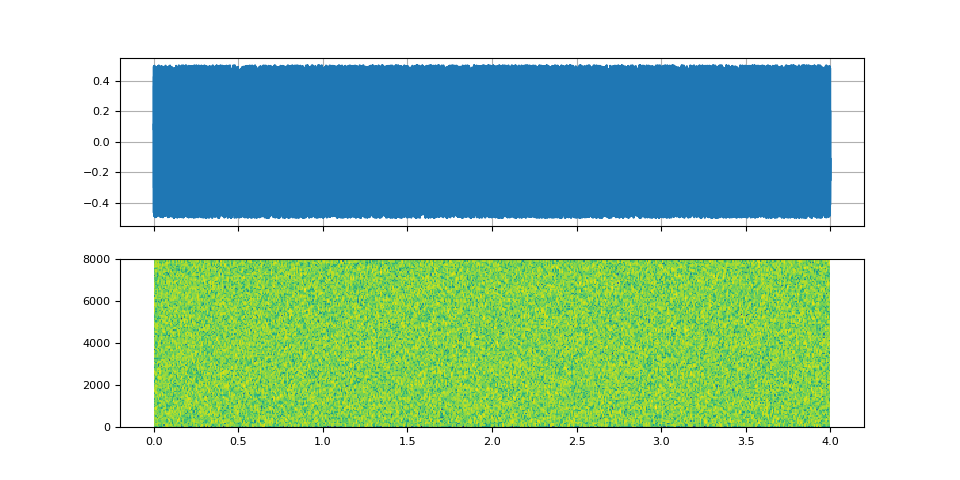
Windowed-sinc filter¶
Sweeping cutoff frequency¶
We use sinc_impulse_response() to
create series of low pass filters, while changing the cut-off
frequency from zero to Nyquist frequency.
num_filters = 64 * duration
window_size = 2049
f_cutoff = torch.linspace(0.0, 0.8, num_filters)
kernel = sinc_impulse_response(f_cutoff, window_size)
/pytorch/audio/examples/tutorials/subtractive_synthesis_tutorial.py:112: UserWarning: torchaudio.prototype.functional._dsp.sinc_impulse_response has been deprecated. This deprecation is part of a large refactoring effort to transition TorchAudio into a maintenance phase. Please see https://github.com/pytorch/audio/issues/3902 for more information. It will be removed from the 2.9 release.
kernel = sinc_impulse_response(f_cutoff, window_size)
To apply time-varying filter, we use
filter_waveform()
/pytorch/audio/examples/tutorials/subtractive_synthesis_tutorial.py:120: UserWarning: torchaudio.prototype.functional._dsp.filter_waveform has been deprecated. This deprecation is part of a large refactoring effort to transition TorchAudio into a maintenance phase. Please see https://github.com/pytorch/audio/issues/3902 for more information. It will be removed from the 2.9 release.
filtered = filter_waveform(noise, kernel)
Let’s look at the spectrogram of the resulting audio and listen to it.
def plot_sinc_ir(waveform, cutoff, sample_rate, vol=0.2):
num_frames = waveform.size(0)
duration = num_frames / sample_rate
num_cutoff = cutoff.size(0)
nyquist = sample_rate / 2
_, axes = plt.subplots(2, 1, sharex=True)
t = torch.linspace(0, duration, num_frames)
axes[0].plot(t, waveform)
axes[0].grid(True)
axes[1].specgram(waveform, Fs=sample_rate, scale="dB")
t = torch.linspace(0, duration, num_cutoff)
axes[1].plot(t, cutoff * nyquist, color="gray", linewidth=0.8, label="Cutoff Frequency", linestyle="--")
axes[1].legend(loc="upper center")
axes[1].set_ylim([0, nyquist])
waveform /= waveform.abs().max()
return Audio(vol * waveform, rate=sample_rate, normalize=False)
plot_sinc_ir(filtered, f_cutoff, SAMPLE_RATE)
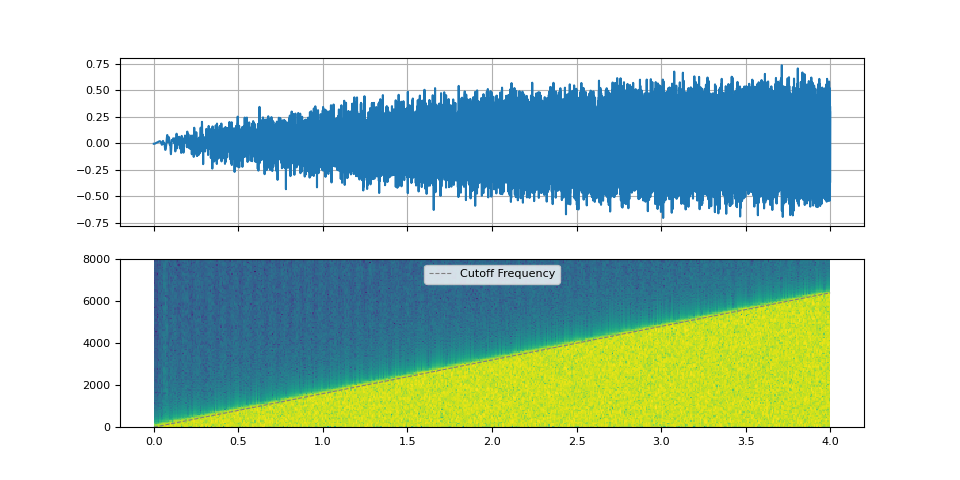
Oscillating cutoff frequency¶
By oscillating the cutoff frequency, we can emulate an effect of Low-frequency oscillation (LFO).
PI2 = torch.pi * 2
num_filters = 90 * duration
f_lfo = torch.linspace(0.9, 0.1, num_filters)
f_cutoff_osci = torch.linspace(0.01, 0.03, num_filters) * torch.sin(torch.cumsum(f_lfo, dim=0))
f_cutoff_base = torch.linspace(0.8, 0.03, num_filters) ** 1.7
f_cutoff = f_cutoff_base + f_cutoff_osci
/pytorch/audio/examples/tutorials/subtractive_synthesis_tutorial.py:172: UserWarning: torchaudio.prototype.functional._dsp.sinc_impulse_response has been deprecated. This deprecation is part of a large refactoring effort to transition TorchAudio into a maintenance phase. Please see https://github.com/pytorch/audio/issues/3902 for more information. It will be removed from the 2.9 release.
kernel = sinc_impulse_response(f_cutoff, window_size)
/pytorch/audio/examples/tutorials/subtractive_synthesis_tutorial.py:173: UserWarning: torchaudio.prototype.functional._dsp.filter_waveform has been deprecated. This deprecation is part of a large refactoring effort to transition TorchAudio into a maintenance phase. Please see https://github.com/pytorch/audio/issues/3902 for more information. It will be removed from the 2.9 release.
filtered = filter_waveform(noise, kernel)
plot_sinc_ir(filtered, f_cutoff, SAMPLE_RATE)

Wah-wah effects¶
Wah-wah effects are applications of low-pass filter or band-pass filter. They change the cut-off freuqnecy or Q-factor quickly.
f_lfo = torch.linspace(0.15, 0.15, num_filters)
f_cutoff = 0.07 + 0.06 * torch.sin(torch.cumsum(f_lfo, dim=0))
/pytorch/audio/examples/tutorials/subtractive_synthesis_tutorial.py:194: UserWarning: torchaudio.prototype.functional._dsp.sinc_impulse_response has been deprecated. This deprecation is part of a large refactoring effort to transition TorchAudio into a maintenance phase. Please see https://github.com/pytorch/audio/issues/3902 for more information. It will be removed from the 2.9 release.
kernel = sinc_impulse_response(f_cutoff, window_size)
/pytorch/audio/examples/tutorials/subtractive_synthesis_tutorial.py:195: UserWarning: torchaudio.prototype.functional._dsp.filter_waveform has been deprecated. This deprecation is part of a large refactoring effort to transition TorchAudio into a maintenance phase. Please see https://github.com/pytorch/audio/issues/3902 for more information. It will be removed from the 2.9 release.
filtered = filter_waveform(noise, kernel)
plot_sinc_ir(filtered, f_cutoff, SAMPLE_RATE)
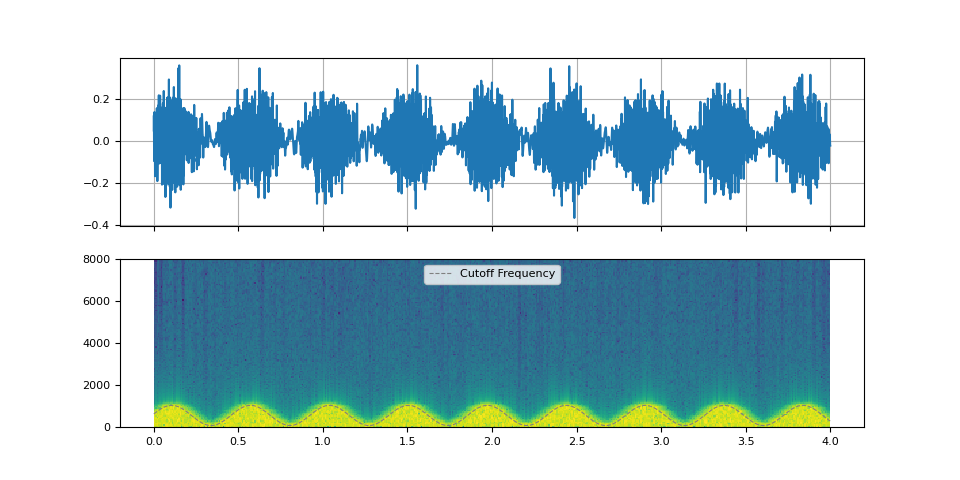
Arbitrary frequence response¶
By using
frequency_impulse_response(),
one can directly control the power distribution over frequency.
magnitudes = torch.sin(torch.linspace(0, 10, 64)) ** 4.0
kernel = frequency_impulse_response(magnitudes)
filtered = filter_waveform(noise, kernel.unsqueeze(0))
/pytorch/audio/examples/tutorials/subtractive_synthesis_tutorial.py:213: UserWarning: torchaudio.prototype.functional._dsp.frequency_impulse_response has been deprecated. This deprecation is part of a large refactoring effort to transition TorchAudio into a maintenance phase. Please see https://github.com/pytorch/audio/issues/3902 for more information. It will be removed from the 2.9 release.
kernel = frequency_impulse_response(magnitudes)
/pytorch/audio/examples/tutorials/subtractive_synthesis_tutorial.py:214: UserWarning: torchaudio.prototype.functional._dsp.filter_waveform has been deprecated. This deprecation is part of a large refactoring effort to transition TorchAudio into a maintenance phase. Please see https://github.com/pytorch/audio/issues/3902 for more information. It will be removed from the 2.9 release.
filtered = filter_waveform(noise, kernel.unsqueeze(0))
def plot_waveform(magnitudes, filtered, sample_rate):
nyquist = sample_rate / 2
num_samples = filtered.size(-1)
duration = num_samples / sample_rate
# Re-organize magnitudes for overlay
N = 10 # number of overlays
interval = torch.linspace(0.05, 0.95, N)
offsets = duration * interval
# Select N magnitudes for overlays
mags = torch.stack(
[magnitudes for _ in range(N)]
if magnitudes.ndim == 1
else [magnitudes[int(i * magnitudes.size(0))] for i in interval]
)
mag_x = offsets.unsqueeze(-1) + 0.1 * mags
mag_y = torch.linspace(0, nyquist, magnitudes.size(-1)).tile((N, 1))
_, ax = plt.subplots(1, 1, sharex=True)
ax.vlines(offsets, 0, nyquist, color="gray", linestyle="--", linewidth=0.8)
ax.plot(mag_x.T.numpy(), mag_y.T.numpy(), color="gray", linewidth=0.8)
ax.specgram(filtered, Fs=sample_rate)
return Audio(filtered, rate=sample_rate)
plot_waveform(magnitudes, filtered, SAMPLE_RATE)

It is also possible to make a non-stationary filter.
magnitudes = torch.stack([torch.linspace(0.0, w, 1000) for w in torch.linspace(4.0, 40.0, 250)])
magnitudes = torch.sin(magnitudes) ** 4.0
kernel = frequency_impulse_response(magnitudes)
filtered = filter_waveform(noise, kernel)
/pytorch/audio/examples/tutorials/subtractive_synthesis_tutorial.py:258: UserWarning: torchaudio.prototype.functional._dsp.frequency_impulse_response has been deprecated. This deprecation is part of a large refactoring effort to transition TorchAudio into a maintenance phase. Please see https://github.com/pytorch/audio/issues/3902 for more information. It will be removed from the 2.9 release.
kernel = frequency_impulse_response(magnitudes)
/pytorch/audio/examples/tutorials/subtractive_synthesis_tutorial.py:259: UserWarning: torchaudio.prototype.functional._dsp.filter_waveform has been deprecated. This deprecation is part of a large refactoring effort to transition TorchAudio into a maintenance phase. Please see https://github.com/pytorch/audio/issues/3902 for more information. It will be removed from the 2.9 release.
filtered = filter_waveform(noise, kernel)
plot_waveform(magnitudes, filtered, SAMPLE_RATE)
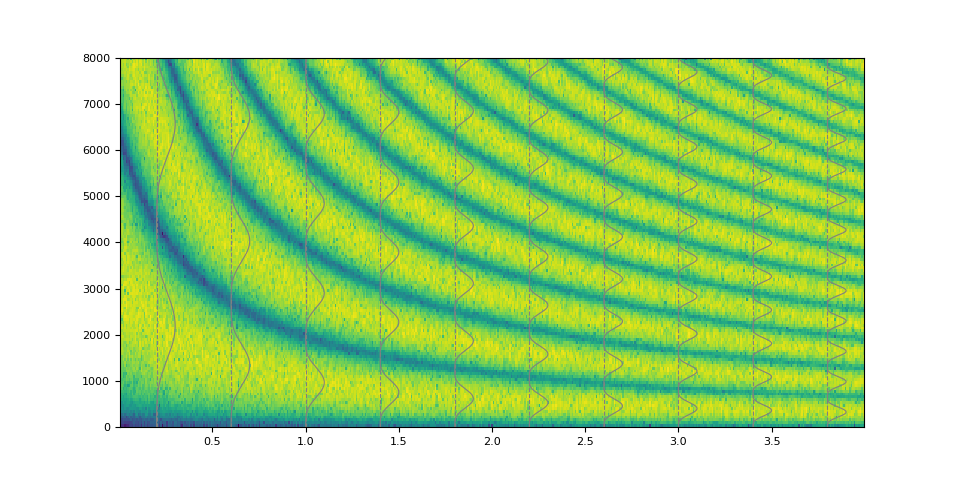
Of course it is also possible to emulate simple low pass filter.
magnitudes = torch.concat([torch.ones((32,)), torch.zeros((32,))])
kernel = frequency_impulse_response(magnitudes)
filtered = filter_waveform(noise, kernel.unsqueeze(0))
/pytorch/audio/examples/tutorials/subtractive_synthesis_tutorial.py:273: UserWarning: torchaudio.prototype.functional._dsp.frequency_impulse_response has been deprecated. This deprecation is part of a large refactoring effort to transition TorchAudio into a maintenance phase. Please see https://github.com/pytorch/audio/issues/3902 for more information. It will be removed from the 2.9 release.
kernel = frequency_impulse_response(magnitudes)
/pytorch/audio/examples/tutorials/subtractive_synthesis_tutorial.py:274: UserWarning: torchaudio.prototype.functional._dsp.filter_waveform has been deprecated. This deprecation is part of a large refactoring effort to transition TorchAudio into a maintenance phase. Please see https://github.com/pytorch/audio/issues/3902 for more information. It will be removed from the 2.9 release.
filtered = filter_waveform(noise, kernel.unsqueeze(0))
plot_waveform(magnitudes, filtered, SAMPLE_RATE)
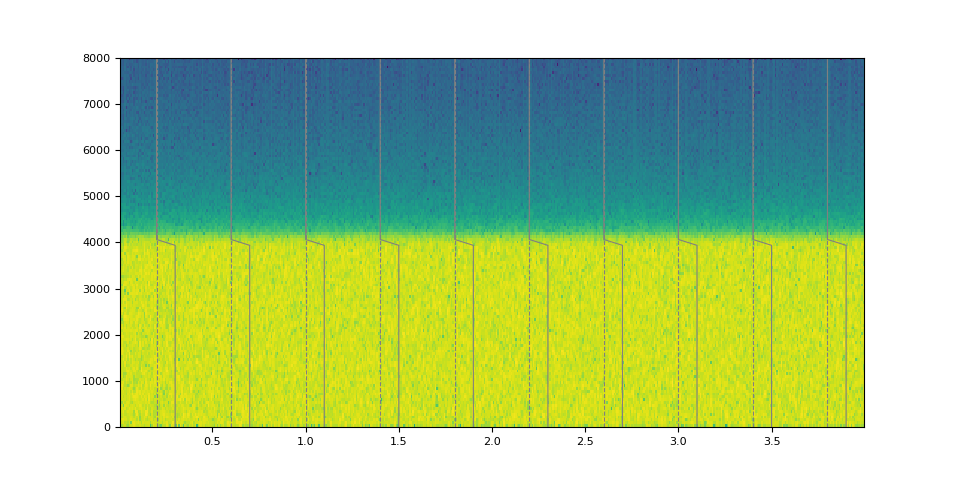
References¶
Total running time of the script: ( 0 minutes 8.339 seconds)



